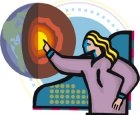
Worksheets and No Prep Teaching Resources
Reading Comprehension Worksheets
Earth Science

Earth Science
 Worksheets and No Prep Teaching Resources Reading Comprehension Worksheets Earth Science |
 Earth Science |
| edHelper's suggested reading level: | grades 9 to 10 | |
| Flesch-Kincaid grade level: | 9.46 |
| Print Earth Files - Age is Relative (font options, pick words for additional puzzles, and more) |
| Quickly print reading comprehension |
| Print a proofreading activity |
|
Earth Files - Age is Relative
By Trista L. Pollard |

|
 1 A farmer in Scotland made one of the most important discoveries in Earth science during the 18th century. This farmer observed the natural changes that took place on his land over the course of time. By observing these geologic changes, James Hutton developed the principle of uniformitarianism. Hutton, in addition to farming, was also a physician. He wrote on various topics including agriculture, weather, climate, and physics. Hutton concluded from his observations that his land was changed by the same geologic forces that changed our planet's surface thousands of years before. These geologic forces or processes, like volcanism and erosion, have helped to shape the Earth's crust since the earliest time. When Hutton spoke and wrote about uniformitarianism, geologists listened. In fact, his principle became one of the foundations of geology.
1 A farmer in Scotland made one of the most important discoveries in Earth science during the 18th century. This farmer observed the natural changes that took place on his land over the course of time. By observing these geologic changes, James Hutton developed the principle of uniformitarianism. Hutton, in addition to farming, was also a physician. He wrote on various topics including agriculture, weather, climate, and physics. Hutton concluded from his observations that his land was changed by the same geologic forces that changed our planet's surface thousands of years before. These geologic forces or processes, like volcanism and erosion, have helped to shape the Earth's crust since the earliest time. When Hutton spoke and wrote about uniformitarianism, geologists listened. In fact, his principle became one of the foundations of geology. |
Create Weekly Reading Books
Prepare for an entire week at once! |
| Leave your feedback on Earth Files - Age is Relative (use this link if you found an error in the story) |
 |
Earth Science
|
 |
High School Reading Comprehensions and High School Reading Lessons
|